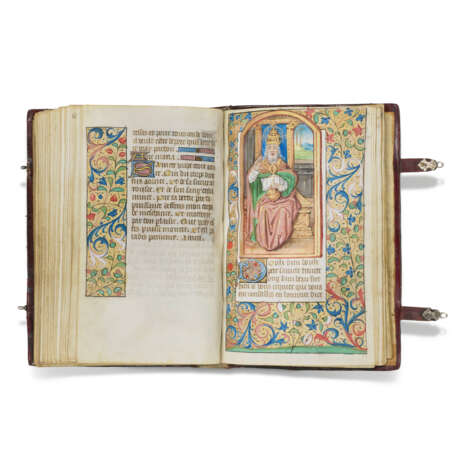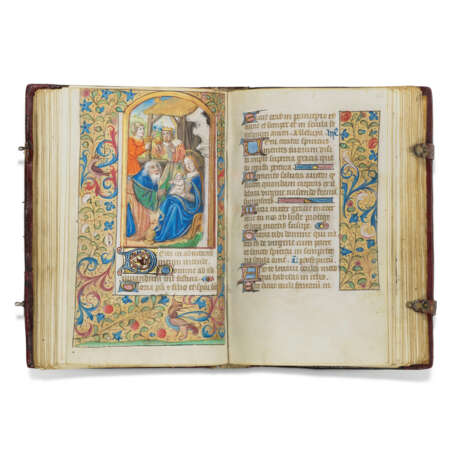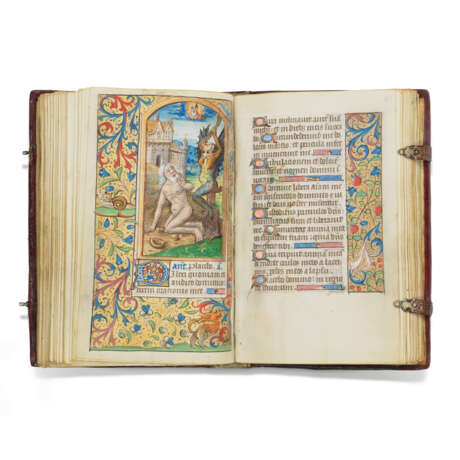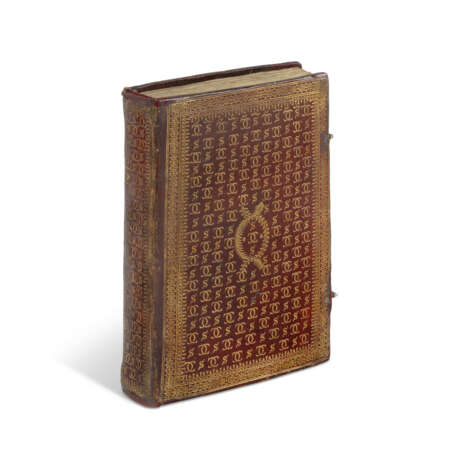ID 794475
Lot 33 | Master of Étienne Poncher
Valeur estimée
£ 40 000 – 60 000
Book of Hours, use of Paris, in Latin and French, illuminated manuscript on vellum [Paris, 1490s]
A striking Book of Hours illuminated in Paris at the end of the 15th century by the Master of Étienne Poncher; later bound for a member of the French royal family, perhaps the bibliophile regent princess Catherine de Bourbon.
155 x 105mm. 147 leaves, complete, modern pencil foliation, 21 lines, ruled space: 102 x 54mm, rubrics in blue, one- to two-line illuminated initials alternating on red and blue grounds throughout, text pages with one-sided panel borders of acanthus and flowers on liquid-gold grounds, 12 bipartite border miniatures in the Calendar with the signs of the Zodiac and the occupations of the months, 23 small miniatures within three-sided borders as before, 15 large miniatures above three-line decorated initials on gold grounds all within full borders of acanthus, flowers, birds, insects and grotesques (the Calendar miniatures with some pigment flaking and a couple of instances of later retouching, the faces of the Annunciation miniature retouched).
Binding: 16th-century French burgundy morocco over thin pasteboard, tooled in gilt, sides and flat spine with a semé with 2 interlaced Cs alternating with an S fermé (possibly the cipher of Catherine de Bourbon, Duchess of Lorraine – see J. Guigard, Nouvel armorial du bibliophile: guide de l’amateur des livres armoriés, vol I (Paris: 1890), pp.119-20 – or that of Charles de Bourbon, Count of Soissons; cf. British Library C47g14), fore-edge clasps with metal catches renewed, gilt edges (spine ends, edges and corners sensitively repaired).
Provenance:
(1) The liturgical use is for Paris, the feasts of patron saints Genevieve and Denis appear in gold in the Calendar, with Genevieve among the saints invoked in the Litany and the Suffrages, and the style of illumination is consistent with the manuscript having been painted in the city at the end of the 15th century.
(2) ?Catherine de Bourbon, Duchess of Lorraine (1559-1604) or, perhaps, Charles de Bourbon, Count of Soissons (1566-1612). Catherine de Bourbon, who served as regent of the principality of Béarn from 1576 until 1596 on behalf of her elder brother, Henry IV of France, was a noted bibliophile who amassed an exceptional library including classical works in Greek and Latin, autograph letters, and illuminated manuscripts, many of which were bound by or in the style of Clovis Eve (active 1583-1633). Charles de Bourbon, Count of Soissons (1566-1612), military commander and prince of the blood, was briefly engaged to be married to Catherine, after fighting for Henry of Navarre during the French Wars of Religion.
(3) ‘Jehan’, signature on final pastedown in a ?17th-century hand.
(4) Rudolf Busch (1876-1956, German bibliophile; sale notice pasted inside upper cover). His sale, by Josef Baer, 3-4 May 1921, lot 268 (see Sammlung Rudolf Busch, Zweiter Teil: Illuminierte Manuscripte, Frankfurt: Joseph Baer & Co., 1921, pp.41-42).
(5) Weiss & Co. Antiquariat, Munich, 1926, cat. 1, no 30.
(6) Karl & Faber, Munich, January 1929, cat. 37, no 3.
(7) Hartung & Hartung, 17 May 2008, lot 18.
(8) Ketterer Kunst, 20 November 2017, lot 14.
Content: Calendar ff.1-12; Gospel extracts ff.13-17v; Obsecro te ff.17v-20v; O intemerata ff.20v-22; Hours of the Virgin, use of Paris, with abbreviated Hours of the Cross and of the Holy Spirit intermixed ff.23-82v: matins f.23, lauds f.40, matins of the Cross f.48v, matins of the Holy Spirit f.50, prime f.51v, terce f.57, sext f.61v, none f.66, vespers f.70v, compline f.77; Seven Penitential Psalms and Litany ff.83-97; Office of the Dead, use of Paris ff.97v-130; Fifteen Joys of the Virgin, in French ff.130v-134; Seven Requests to our Lord, in French ff.135-137v; Suffrages ff.137v-147; Communion prayers, in French, added in a later hand ff.147v-i.
Illumination:
The miniatures in the present manuscript are attributable to the Master of Étienne Poncher, an artist named after the French prelate, diplomat and bishop of Paris for whom he produced a Pontifical (Bibliothèque nationale de France, lat.956) and a second manuscript entitled Les empereurs de Rome et les roys de France (see I. Delaunay, Échanges artistiques entre livres d’heures manuscrits et imprimés produits à Paris vers 1480-1500, 2000, pp.289-310). Characteristic features of his style are the strong-nosed, ruddy-cheeked, fluffy-bearded old men and the snowy-skinned female figures, all with lips dotted in red. Supposed to have been an apprentice of the Master of Jacques de Besançon, the Master of Étienne Poncher shares his predecessor’s taste for a more developed visual narrative. He incorporates a wealth of detail across his miniatures to inspire the imagination of the viewer: cities and buildings are comprehensively rendered against the skyline, landscapes are populated with distant figures, and supporting actors are imbued with personality and an active role in the narrative: from the shepherd gazing into the water during the Annunciation (f.57) or the two kings in the background of the Adoration (f.61v), to the flamboyant Devil who torments Job (f.97v).
The subjects of the large miniatures are as follows: St John on Patmos f.13; Annunciation f.23; Visitation f.40; Crucifixion f.48v; Pentecost f.50; Nativity f.51v; Annunciation to the Shepherds f.57; Adoration of the Magi f.61v; Presentation in the Temple f.66; Flight into Egypt f.70; Coronation of the Virgin f.77; David in Prayer f.83r; Satan tests Job f.97v; Madonna and Child on a Crescent Moon f.130v; God the Father Enthroned f.135.
Special notice
No VAT on hammer price or buyer's premium.
| Lieu d'origine: | Europe de l'Ouest, France, Europe |
|---|---|
| Catégorie maison de vente aux enchères: | Manuscrits médiévaux et de la Renaissance |
| Lieu d'origine: | Europe de l'Ouest, France, Europe |
|---|---|
| Catégorie maison de vente aux enchères: | Manuscrits médiévaux et de la Renaissance |
| Adresse de l'enchère |
CHRISTIE'S 8 King Street, St. James's SW1Y 6QT London Royaume-Uni | |
|---|---|---|
| Aperçu |
| |
| Téléphone | +44 (0)20 7839 9060 | |
| Commission | see on Website | |
| Conditions d'utilisation | Conditions d'utilisation |








